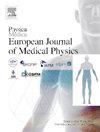Comparative analysis of deep learning methods for breast ultrasound lesion detection and classification
IF 3.3
3区 医学
Q1 RADIOLOGY, NUCLEAR MEDICINE & MEDICAL IMAGING
Physica Medica-European Journal of Medical Physics
Pub Date : 2025-05-16
DOI:10.1016/j.ejmp.2025.104993
引用次数: 0
Abstract
Purpose
Breast ultrasound (BUS) computer-aided diagnosis (CAD) systems aims to perform two major steps: detecting lesions and classifying them as benign or malignant. However, the impact of combining both steps has not been previously addressed. Moreover, the specific method employed can influence the final outcome of the system.
Materials and methods
In this work, a comparison of the effects of using object detection, semantic segmentation and instance segmentation to detect lesions in BUS images was conducted. To this end, four approaches were examined: a) multi-class object detection, b) one-class object detection followed by localized region classification, c) multi-class segmentation, and d) one-class segmentation followed by segmented region classification. Additionally, a novel dataset for BUS segmentation, called BUS-UCLM, has been gathered, annotated and shared publicly. The evaluation of the methods proposed was carried out with this new dataset and four publicly available datasets: BUSI, OASBUD, RODTOOK and UDIAT.
Results
Among the four approaches compared, multi-class detection and multi-class segmentation achieved the best results when instance segmentation CNNs are used. The best results in detection were obtained with a multi-class Mask R-CNN with a COCO AP50 metric of 72.9%. In the multi-class segmentation scenario, Poolformer achieved the best results with a Dice score of 77.7%.
Conclusions
The analysis of detection and segmentation models in BUS highlights several key challenges, emphasizing the complexity of accurately identifying and segmenting lesions. Among the methods evaluated, instance segmentation has proven to be the most effective for BUS images, offering superior performance in delineating individual lesions.
深度学习方法在乳腺超声病变检测与分类中的比较分析
目的乳腺超声(BUS)计算机辅助诊断(CAD)系统旨在完成两个主要步骤:检测病变并将其分类为良性或恶性。然而,这两个步骤结合起来的影响以前没有得到解决。此外,所采用的具体方法会影响系统的最终结果。材料与方法在本工作中,比较了使用目标检测、语义分割和实例分割在BUS图像中检测病变的效果。为此,研究了四种方法:a)多类目标检测,b)一类目标检测后局部区域分类,c)多类分割,d)一类分割后局部区域分类。此外,一个新的总线分割数据集,称为BUS- uclm,已经被收集、注释和公开共享。使用该新数据集和四个公开可用的数据集(BUSI, OASBUD, rodtake和UDIAT)对所提出的方法进行了评估。结果四种方法中,使用实例分割cnn时,多类检测和多类分割效果最好。多层掩膜R-CNN的检测效果最好,COCO AP50指标为72.9%。在多类分割场景中,Poolformer获得了最好的结果,Dice得分为77.7%。结论对BUS的检测和分割模型的分析突出了几个关键挑战,强调了准确识别和分割病变的复杂性。在评估的方法中,实例分割被证明是对BUS图像最有效的,在描绘单个病变方面提供了优越的性能。
本文章由计算机程序翻译,如有差异,请以英文原文为准。
求助全文
约1分钟内获得全文
求助全文
来源期刊
CiteScore
6.80
自引率
14.70%
发文量
493
审稿时长
78 days
期刊介绍:
Physica Medica, European Journal of Medical Physics, publishing with Elsevier from 2007, provides an international forum for research and reviews on the following main topics:
Medical Imaging
Radiation Therapy
Radiation Protection
Measuring Systems and Signal Processing
Education and training in Medical Physics
Professional issues in Medical Physics.

 求助内容:
求助内容: 应助结果提醒方式:
应助结果提醒方式:


